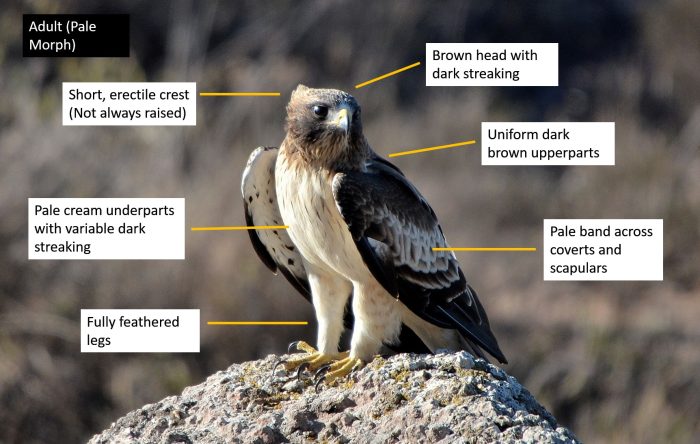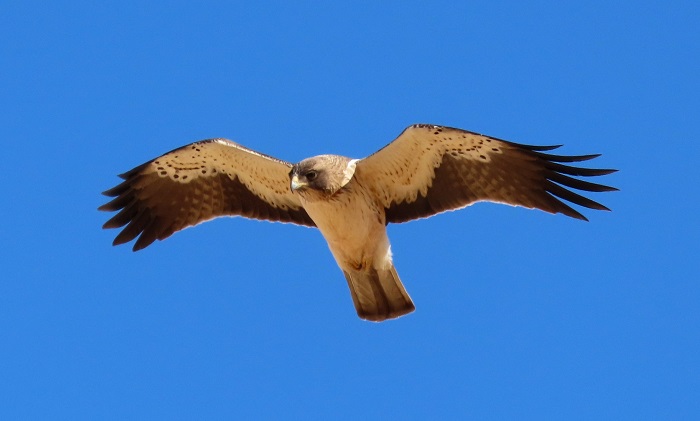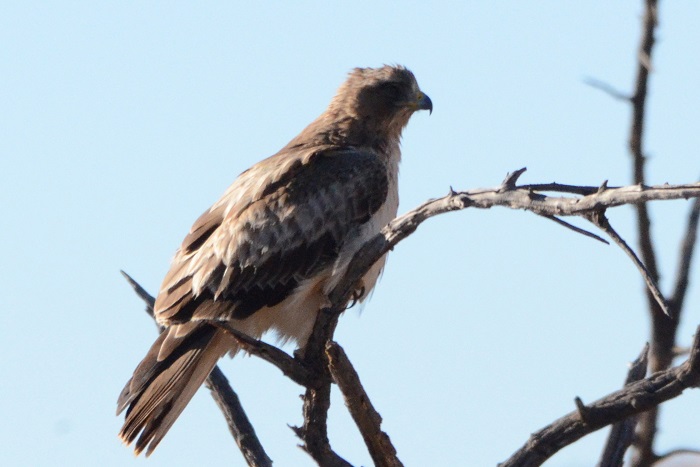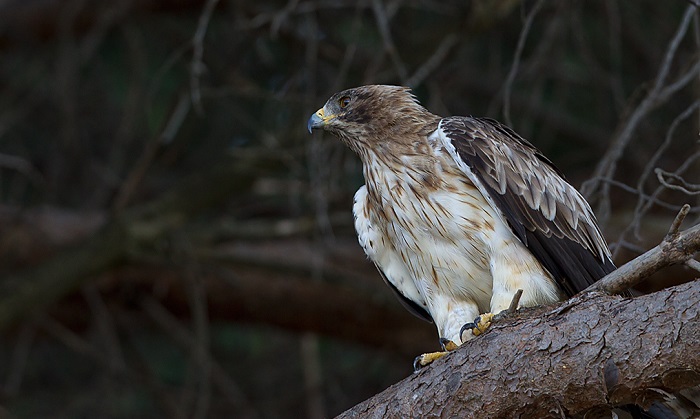Cover image: Booted Eagle by Gregg Darling – Paarl mountain Reserve, Western Cape – BirdPix No. 6148
Identification
The Booted Eagle has a compact, stocky build and is the smallest brown eagle in southern Africa. The sexes are alike in plumage but they differ in size, females being substantially larger than males. Females weigh up to 975 g and can attain a wingspan of 1.35 m

Britannia Bay, Western Cape
Photo by John Todd
The Booted Eagle is a variable species and can be found in three colour forms, a pale morph, a dark morph and the rare rufous morph. Pale morph birds make up roughly 80% of all individuals in Southern Africa.
Pale form birds have brown upperparts, including the head, and pale cream coloured underparts, with a variable amount of brown streaking on the chest. Dark morph birds are entirely dark brown with dark streaking below. The rufous morph is intermediate between the dark and pale morphs and has variable, rufous underparts. All colour morphs show a band of buff-tipped feathers on the folded wings.

Victoria West dam, Northern Cape
Photo by Sybrand Venter
At certain angles in flight, shows pale patches or ‘landing lights’ on the leading edge of the wings, close to the body. This is the most distinguishing feature of this species but is not clear from all angles and is less conspicuous on pale form individuals. Additionally, when seen flying from below, there is a distinctive pale wedge at the bend of the wing.

Greyton district, Western Cape
Photo by Stuart Shearer
Inset photo by Pamela Kleiman – Calitzdorp district, Western Cape
Juveniles resemble their respective adult morph but have buffy feathers on the upper wing coverts, secondaries and tail feathers.
The Booted Eagle could be mistaken for other similarly sized brown raptors such as Wahlberg’s Eagle Hieraaetus wahlbergi, Lesser Spotted Eagle Clanga pomarina, Black Kite Milvus migrans and juvenile Ayre’s Hawk Eagle Hieraaetus ayresii.
The Black Kite lacks the white ‘landing lights’ and has a shallowly forked (not slightly rounded) tail. Wahlberg’s Eagle has longer, straighter wings and a narrow, rectangular tail, and also lacks the white ‘landing lights’. Juvenile Ayres’s Hawk-Eagle is more compact, with strong barring on the under wings and tail. The Lesser Spotted Eagle is larger with broader wings and a shorter, broader tail. It too lacks the diagnostic ‘landing lights’ of the Booted Eagle.

Teza Lake, KwaZulu-Natal
Photo by Dave Rimmer
Status and Distribution
The Booted Eagle is a very widespread species, occurring across Africa, southern and eastern Europe, parts of western and central Asia and the Indian subcontinent.
It is fairly common but localised throughout Southern Africa and is most numerous in the winter rainfall regions of South Africa.

There are three populations of Booted Eagles in southern Africa. The first comprises birds that breed in the winter rainfall region of the Northern, Western and Eastern Cape. These birds disperse into other parts of southern Africa after breeding. The second population is small and breeds on the Waterberg Plateau in Namibia. The third are non-breeding Palearctic migrants from Eurasia and North Africa. Local breeding birds are indistinguishable from Palearctic birds.
It is possible that the establishment of local breeding populations is a recent phenomenon and the species is perhaps undergoing an increase in numbers and breeding range.
Habitat

Photo by Ryan Tippett
The Booted Eagle is restricted to breeding on cliffs in mountainous country but hunts in both hilly and flat terrain.
It is most common in the dwarf shrublands of the Karoo and in fynbos. Non-breeding migrants are found in a variety of non-forested habitats, including open woodland, grassland, desert and semi-desert. It avoids forested and densely wooded habitats.

Clanwilliam, Western Cape
Photo by Zenobia van Dyk
Behaviour
The Booted Eagle is usually encountered solitarily or in pairs. It is inconspicuous when perched and is usually only seen when flying. Soars frequently, especially during the warmest part of the day.

Klein Aus Vista, Namibia
Photo by Johan and Estelle van Rooyen
The booted Eagle is fast and agile on the wing and most hunting is done in flight, either after a long, near vertical stoop dive or after a chase in level flight. Sometimes also hunts from a perch

Velddrif, Western Cape
Photo by Eddie du Plessis
The diet consists mainly of a wide range of bird species up to the size of francolins or guineafowl, but also takes lizards, rodents, and insects such as locusts and termite alates. They will drink water regularly during hot conditions.

Kgalagadi Transfrontier Park, Northern Cape
Photo by Jon Blanco
In Southern Africa breeding birds nest on cliff faces, often at the base of a tree growing out of the rock face. Birds breed between August and January in South Africa with a peak between September and November. Namibian birds on the Waterberg plateau in winter with a peak in June.
Booted Eagles are monogamous and mate fidelity is high with pairs remaining together for successive seasons. They are territorial but are tolerant of conspecifics breeding nearby.

Middelburg district, Eastern Cape
Photo by Tino Herselman
The nest is a surprisingly small platform of sticks and twigs, lined with fresh green leaves. It is constructed and repaired by both sexes and the nest is frequently re-used over many years.
Two mostly white eggs with feint reddish speckling are laid per clutch. Incubation is performed mostly by the female and the incubation period lasts for around 40 days. Both chicks are often raised but cainism sometimes occurs. The nestling period takes a further 50 to 54 days. During this time the chicks are fed predominantly by the female while the male does most of the hunting. Fledged juveniles remain near the nest for some time and remain dependent on the parents for up to 60 days or so.

Strandfontein, Western Cape
Photo by Gerald Wingate
Further Resources
This species text is adapted from the first Southern African Bird Atlas Project (SABAP1), 1997.
The use of photographs by Dave Rimmer, Eddie du Plessis, Gerald Wingate, Gregg Darling, Johan and Estelle van Rooyen, John Todd, Jon Blanco, Les Underhill, Pamela Kleiman, Stuart Shearer, Sybrand Venter, Tino Herselman and Zenobia van Dyk is acknowledged.
Virtual Museum (BirdPix > Search VM > By Scientific or Common Name).
Other common names: Dwergarend (Afrikaans); Dwergarend (Dutch); Aigle botté (French); Zwergadler (German); Águia-calçada (Portuguese).
List of species available in this format.
Recommended citation format: Tippett RM 2023. Booted Eagle Aquila pennatus. Biodiversity and Development Institute. Available online at http://thebdi.org/2023/09/07/booted-eagle-aquila-pennatus/

Batlako Dam, North West
Photo by Les Underhill

